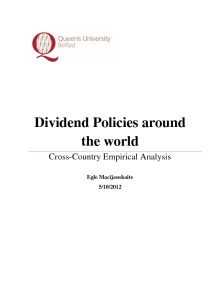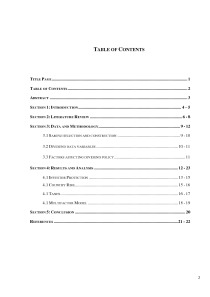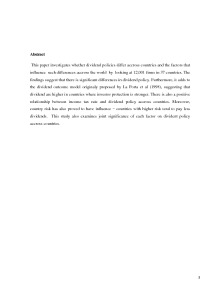Dividend Policies Around The World



Section Results and AnalysisSection Conclusion020 References021 - 22 Abstract. Section Literature Review. Section Data and Methodology. Grand Total Section Results and Analysis.
This paper investigates whether dividend policies differ accross countries and the factors that influence such differences accross the world by looking at 12,001 firms in 37 countries. The findings suggest that there is significant differences in dividend policy. Furthermore, it adds to the dividend outcome model originaly proposed by La Porta et al (1998), suggesting that dividend are higher in countries where investor protection is stronger. There is also a positive relationship between income tax rate and dividend policy accross countries. Moreover, country risk has also proved to have influence – countries with higher risk tend to pay less dividends. This study also examines joint significance of each factor on divident policy accross countries.
Since Miller and Modigliani‘s (1961) proposal of the irrelevance theory, dividends have been subject to research and debates amongst many researchers over time. The existing differences of dividend policies amongs firms makes us question what influences managers to adopt certain policies – why some firms choose to pay dividends, while others do not and why some pay more than others once they make the decision to pay? Black (1996) accurately described dividend policy as a puzzle, that becomes even more difficult to solve the more we look at it.
Dividend theories and literature suggest some explanations why dividend policies vary accross firms. Michel (1979) suggests that different industries tend to follow different dividend policies because each industry has different characteristics. For example, young growth firms tend to pay lower dividends than mature value firms. Firms face a decision between retaining the profits for reinvestment in profitable projects and distributing the cash to shareholders. This is quite influential that growth firms will therefore retain the cash and invest in other projects, while mature firms do not have as many investment opportunities therefore will pay out more in dividends.
However, it has been observed that dividend policies differ across countries as well. Traditionally, the differences in tax systems and variations of the extent of agency problem across countries (La Porta et al 1998) attempt to explain these differences in dividend policy. Another determining factor suggested by Michel and Shaked (1986), Glen et al. (1995), Travlos et al.(2001), Kang and Lee (2003), and Kang (2004) is that firms in different countries may follow different dividend policies because of differences in macro-economic environments, economic developments, regulations and other institutional factors. Another particularly popular idea that firms pay dividends to signal future growth and profitability prospects to investors was largely supported by John and Williams (1985) and Miller and Rock (1985) and this view proved to be quite a success hystorically. However, more recent work by DeAngelo and Skinner (1996, 2003), Benartzi, Michaeli and Thaler (1997) showed that dividend changes cannot predict future earnings of a firm.
- Economy & Finance Individual works
- Microsoft Word 804 KB
- 2018 m.
- English
- 23 pages (5389 words)
- University
- Egle

















